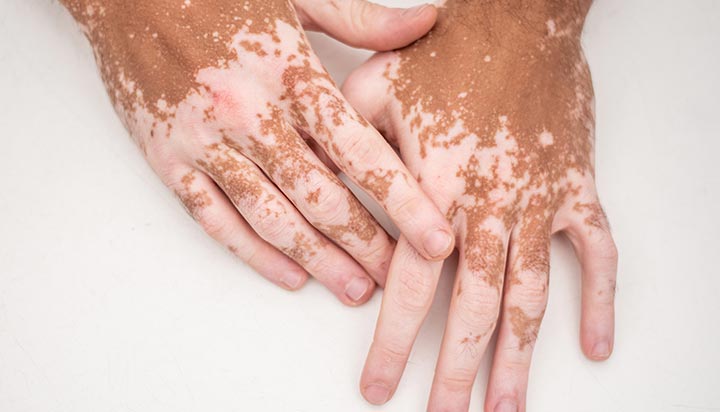Vitiligo: Symptoms, Causes, Treatment
What are the symptoms of vitiligo?
Vitiligo is a skin condition characterized by the loss of pigment in patches of skin, resulting in irregular white patches. The symptoms of vitiligo can vary from person to person, but common symptoms include:
- Depigmented patches: The most noticeable symptom of vitiligo is the presence of depigmented (white) patches of skin. These patches can occur anywhere on the body and may be small or large in size.
- Symmetrical patterns: In many cases, vitiligo patches appear in symmetrical patterns, meaning they occur on both sides of the body in similar locations.
- Progressive spreading: Vitiligo patches may spread over time, either gradually or in sudden spurts.
- Loss of color in mucous membranes: In addition to affecting the skin, vitiligo can also cause the loss of pigment in mucous membranes, such as the lips, mouth, and genital area.
- Premature graying of the hair: People with vitiligo may experience premature graying of the hair on the scalp, eyebrows, eyelashes, or beard.
- Change in eye color: In some cases, vitiligo can cause a change in the color of the iris (the colored part of the eye).
- Sensitivity to sunlight: The depigmented patches of skin in vitiligo are more sensitive to sunlight and may burn easily.
- Emotional impact: Vitiligo can have a significant emotional impact on individuals, leading to feelings of self-consciousness, low self-esteem, and depression.
It’s important to note that the progression and severity of vitiligo can vary widely among individuals. Some people may experience only a few small patches of depigmented skin, while others may have more extensive involvement. If you notice any changes in your skin color or have concerns about vitiligo, it’s important to see a dermatologist for an evaluation and appropriate management.
What are the causes of vitiligo?
The exact cause of vitiligo is not known, but it is believed to be a complex interplay of genetic, autoimmune, and environmental factors. Some possible causes and risk factors for vitiligo include:
- Autoimmune response: One of the leading theories is that vitiligo is an autoimmune disease, where the body’s immune system mistakenly attacks and destroys melanocytes, the cells that produce pigment in the skin.
- Genetics: Vitiligo tends to run in families, suggesting a genetic component to the condition. However, not everyone with a family history of vitiligo will develop the condition.
- Environmental triggers: Environmental factors, such as exposure to certain chemicals, stress, or trauma to the skin, may trigger or exacerbate vitiligo in susceptible individuals.
- Neurochemical factors: Some research suggests that neurochemicals released by nerve endings in the skin may contribute to the development of vitiligo.
- Hormonal changes: Changes in hormone levels, such as those that occur during puberty, pregnancy, or menopause, may play a role in the development or worsening of vitiligo.
- Viral or bacterial infections: Some infections, such as those caused by the Epstein-Barr virus, have been associated with the onset of vitiligo in some cases.
- Oxidative stress: Increased oxidative stress in the skin, caused by factors such as exposure to sunlight or environmental pollutants, may contribute to the development of vitiligo.
It’s important to note that vitiligo is not contagious and cannot be spread from person to person through contact. While the exact cause of vitiligo is not fully understood, research is ongoing to better understand the underlying mechanisms of the condition. If you have vitiligo or are concerned about developing it, it’s important to consult with a dermatologist for an accurate diagnosis and appropriate management.
What is the treatment for vitiligo?
Treatment for vitiligo aims to restore pigment to the affected skin and may vary depending on the extent and severity of the condition. Some common treatments for vitiligo include:
- Topical corticosteroids: These medications are applied to the skin to help reduce inflammation and promote the re-pigmentation of the skin.
- Topical calcineurin inhibitors: These medications, such as tacrolimus or pimecrolimus, can help reduce inflammation and promote re-pigmentation.
- Phototherapy: Phototherapy, or light therapy, involves exposing the skin to ultraviolet A (UVA) or ultraviolet B (UVB) light to stimulate pigment production in the skin. This treatment is often used in combination with other treatments.
- Excimer laser: This type of laser therapy delivers a concentrated beam of UVB light to the affected areas of skin, stimulating pigment production.
- Depigmentation: In cases where vitiligo affects a large area of the skin, depigmentation may be an option. This involves using topical medications to lighten the unaffected skin to match the depigmented areas.
- Surgical treatments: Surgical options for vitiligo include skin grafting, where healthy skin is transplanted to the affected areas, and melanocyte transplantation, where melanocytes (pigment-producing cells) are transplanted to the skin from other parts of the body.
- Cosmetic camouflage: Makeup or self-tanning products can be used to cover the depigmented areas of skin.
It’s important to note that not all treatments will be effective for everyone with vitiligo, and it may take time to find the right treatment or combination of treatments. Additionally, some treatments may have side effects or risks, so it’s important to discuss the options with a dermatologist or healthcare provider. It’s also important to protect the skin from sun exposure, as sunburn can worsen vitiligo.




